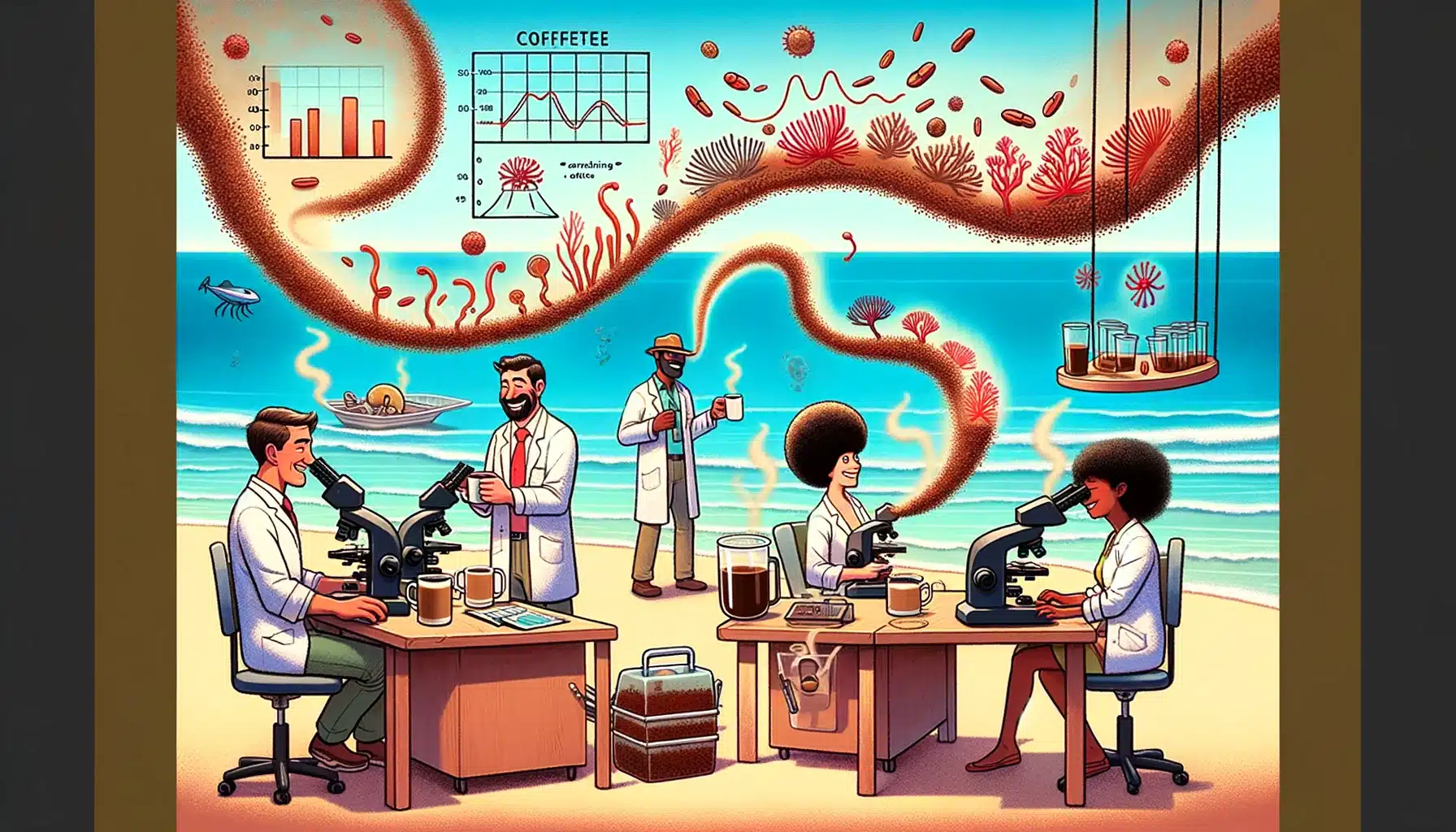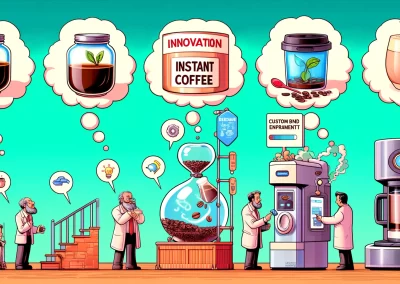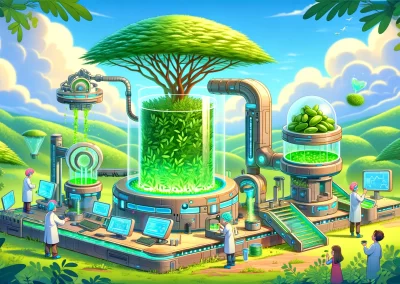How Drinking Coffee Aids in Red Tide Research: When individuals enjoy their daily cup of coffee, they rarely consider the connection between this energizing beverage and the scientific world, particularly in the field of marine biology. Yet, the benefits of coffee extend beyond its ability to perk up the morning routine. Researchers looking into the environmental and health impacts of red tide—an algal bloom that discolors coastal waters and can have detrimental effects on marine life and human health—are finding an unlikely ally in coffee.

The compounds found in coffee are proving useful as part of the investigatory process for understanding red tide. Scientists have observed that caffeine, a well-known stimulant found in coffee, can serve as a tracer in coastal waters to help assess human-derived pollution, which has been linked with exacerbating red tide blooms. Consequently, analyzing caffeine levels in the water helps researchers track the flow and impact of contaminants, contributing to the development of more effective red tide mitigation strategies. As these efforts continue, the relationship between our consumption habits and environmental research becomes increasingly intertwined, showcasing how everyday items can play a role in addressing ecological challenges.
While most people may not directly participate in marine research, their coffee consumption inadvertently assists in understanding the complex phenomena affecting our oceans. The use of coffee in red tide research stands as a testament to the unexpected ways in which human activities intersect with ecological studies. As researchers delve into the causes and impacts of harmful algal blooms, the insights gained from coffee-derived data are helping to protect aquatic ecosystems and human health alike.
The Science of Red Tide
Red tide, a natural phenomenon involving algal blooms, has become a subject of interest due to its increasing frequency and impact on marine ecosystems. Researchers examine various aspects of these events to understand and mitigate their effects.
Understanding Dinoflagellate Blooms
Dinoflagellates are a group of microorganisms crucial to the science behind red tide events. They can rapidly multiply, resulting in blooms that discolor the water and create a ‘red tide’. The species Karenia brevis is often responsible for these occurrences in the Gulf of Mexico. These blooms produce toxins that can be harmful to marine life, humans, and the environment. Studies such as how coffee helps in the fight against red tide have opened innovative pathways for researchers to address the challenges posed by these marine phenomena.
Impact of Climate Change on Red Tides
Climate change significantly influences red tide dynamics, as temperature shifts may create conditions favorable for dinoflagellate proliferation. Rising sea temperatures and altered ocean currents can extend the duration and intensity of red tide events, leading to more frequent and severe impacts on nature and human communities. This interaction underscores the need for comprehensive research to adapt and respond to these environmental challenges.
Coffee in Research

Coffee, often synonymous with caffeine, has found a unique place in various scientific fields. It not only boosts energy and concentration among researchers but is also an object of the study itself.
Caffeine’s Role in Scientific Studies
Caffeine, the active ingredient in coffee, is recognized for its stimulating effects on the human nervous system. Researchers often rely on the energy and concentration enhancement it provides during long and strenuous research sessions. Studies on caffeine have linked it to a positive impact on mental alertness and cognitive function, which can be crucial for staff involved in meticulous scientific analysis.
Coffee Byproducts in Red Tide Analysis
Researchers are looking into coffee byproducts as a potential tool in analyzing and mitigating red tide events—harmful algal blooms that can devastate marine ecosystems. The use of coffee byproducts, rich with compounds that can bind to toxins produced by red tide organisms, shows promise in identifying and neutralizing these toxins, benefiting both health and environmental research efforts.
Health Implications of Coffee

Coffee is not just a popular morning beverage; its consumption can have various effects on health, including impacts on heart rate, blood pressure, and the risk of developing certain conditions. This section outlines the aspects of coffee related to caffeine side effects, cardiac health, and diabetes management.
Understanding Caffeine Side Effects
Caffeine is a central nervous system stimulant found in coffee, and its side effects vary depending on an individual’s caffeine sensitivity. For some, caffeine may cause jitteriness, increased heart rate, and elevated blood pressure. It’s important to recognize one’s own sensitivity to caffeine and consume coffee in moderation to avoid such side effects.
Coffee and Cardiovascular Health
Research indicated on Mayo Clinic suggests that coffee can have nuanced effects on cardiovascular health. While moderate coffee consumption might be associated with a lower risk of cardiovascular disease, excessive intake could potentially lead to negative outcomes. The antioxidants in coffee may be beneficial, but it’s essential to balance intake.
The Relationship Between Coffee Consumption and Diabetes
Studies, including those found on PMC, have explored a potential link between coffee consumption and a reduced risk of developing type 2 diabetes. Components in coffee might help in glucose metabolism, contributing to a reduced risk. However, adding excessive sugar or cream could counteract these benefits, and it’s recommended to enjoy coffee in its less processed forms.
Environmental and Societal Impact

Understanding the role of coffee in aiding red tide research brings to light the broader environmental and societal impacts involved. These effects span from the immediate repercussions on wildlife and agriculture to the varied ways communities and societies respond to red tide events.
Red Tide’s Effect on Wildlife and Agriculture
Red tide events are marked by the proliferation of toxic algae known as Karenia brevis, which harm both marine life and coastal ecosystems. The toxins released by these algal blooms can lead to mass fish kills, leaving dead sea life to wash ashore. This not only disrupts the marine food chain, but it also affects local fisheries that rely on healthy populations for their livelihoods. Birds, marine mammals, and turtles are also affected, often experiencing respiratory issues or even death after exposure to red tide’s toxins.
On land, red tide can contaminate fresh water supplies and agricultural lands, challenging the safety and quality of crops. Moreover, airborne toxins can drift inland, affecting the health of both wild and domesticated animals and leading to economic strains in the agriculture industry.
Societal Response to Red Tide Events
When red tide blooms intensify, communities and local authorities mobilize to mitigate their impacts. There’s often an increased focus on wildlife conservation efforts, as volunteers and conservation groups work together to rescue affected animals and rehabilitate them back to health. Meanwhile, local governments may issue safety warnings, advising residents and tourists on beach closures and seafood consumption guidelines.
The community plays a crucial role in responding to and recovering from red tide events. Public awareness campaigns by industrial and environmental groups aim to educate people on the dangers of red tide and the importance of reducing pollution, which can exacerbate algal bloom conditions. These community-led efforts reflect a growing recognition of the need for safety protocols and proactive environmental stewardship to protect their local ecosystems.
Takeaways and Best Practices

When considering how drinking coffee aids in red tide research efforts, several key points and best practices emerge:
- Moderation is Crucial: Researchers should practice moderation in coffee consumption to maintain optimal health and cognitive function while studying red tide phenomena.
- Health Benefits: Coffee may offer health advantages such as protection against Parkinson’s disease and type 2 diabetes, beneficial for the long hours spent in research. These findings underscore the importance of health care considerations for researchers in the field.
- Educational Insights: Incorporating findings on coffee’s benefits into education programs can be advantageous for students and professionals studying environmental sciences, including red tide research.
- Communication and Collaboration: Coffee can act as an informal means of fostering communication among researchers, leading to collaborative efforts and information-sharing in red tide studies.
- At School: It’s beneficial for students and faculty members to consume coffee in moderation to enhance alertness and concentration during red tide research coursework.
Best Practices Table
| Best Practice | Description |
|---|---|
| Moderation | Limit intake to avoid negative health impacts. |
| Health Awareness | Recognize coffee’s potential benefits and risks for researchers. |
| Educational Content | Teach about coffee’s effects within environmental science programs. |
| Research Collaboration | Use breaks as opportunities for networking and idea exchange. |
| School Guidelines | Suggest guidelines for coffee intake for students and staff. |
By adhering to these best practices, one can enhance their contribution to red tide research while also taking care of their well-being.










